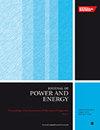双面技术 Pv 系统的特性分析
IF 1.1
4区 工程技术
Q3 ENGINEERING, MECHANICAL
Proceedings of the Institution of Mechanical Engineers, Part A: Journal of Power and Energy
Pub Date : 2024-04-29
DOI:10.1177/09576509241250128
引用次数: 0
摘要
近年来,双面太阳能技术经历了指数式增长,其趋势在未来几年也将不断增强。考虑到双面太阳能技术与单面技术相比所具有的优势,如目前的同等价格、背面生产带来的性能提升以及 LCOE 的持续降低,越来越多的光伏电站采用这种技术是顺理成章的。目前,在双面技术方面还存在一些监管空白,因此有必要研究、调查和实施评估这些系统的最佳方法。本文对一个 3.3 千瓦的双面光伏系统进行了实验,该系统分为两个不同配置的组串,其监控系统配备了 IEC 61,724 标准中的所有仪器,此外还在系统的不同位置安装了多个后部辐照度传感器,以评估该参数的变化情况。经过 9 个月的实验,使用不同的后部辐照度传感器进行了功率估算分析,并计算了 PR 和 PR25°C。该参数的变化取决于传感器的位置,对结果产生的影响是,功率估算的 RMSE 在 10.22% 和 2.63% 之间变化,而系统的 PR 和 PR25°C 在最不利的情况下为 0.84,在最有利的情况下为 0.95。考虑到性能比之间的巨大差异,有必要为双面光伏系统的评估制定一个具体的规范标准。本文章由计算机程序翻译,如有差异,请以英文原文为准。
Characterization of bifacial technology Pv systems
Bifacial solar technology has experienced exponential growth in recent years and its trend is increasing for the coming years. Considering the advantages that it offers over monofacial technology such as its current price equivalence, the increase in performance thanks to the production of the rear face and the consecutive reduction of the LCOE, it is logical that more and more photovoltaic plants with this technology are been installed. Nowadays, there are some regulatory gaps regarding bifacial technology and, due to this growing trend, it is necessary to study, research and implement the optimal way to evaluate these systems. This article has experimented with a 3.3 kW bifacial photovoltaic system, divided into two strings with different configurations, whose monitoring system has all the instrumentation included in the IEC 61,724 standard, with the addition that it has several rear irradiance sensors arranged in different locations of the system to evaluate the variability of this parameter. After an experimental campaign of 9 months, a power estimation analysis and the calculation of the PR and PR25°C have been carried out using the different rear irradiance sensors. The variability of this parameter depending on the location of the sensor has affected the results in such a way that the RMSE committed in the power estimation has varied between 10.22% and 2.63%, while the PR and PR25°C of the system has oscillated between 0.84 for the most unfavorable case and 0.95 in the most favorable case. Assumed the great variability between performance ratios, it is necessary to establish a specific normative standard for the evaluation of Bifacial PV systems.
求助全文
通过发布文献求助,成功后即可免费获取论文全文。
去求助
来源期刊

CiteScore
3.30
自引率
5.90%
发文量
114
审稿时长
5.4 months
期刊介绍:
The Journal of Power and Energy, Part A of the Proceedings of the Institution of Mechanical Engineers, is dedicated to publishing peer-reviewed papers of high scientific quality on all aspects of the technology of energy conversion systems.
 求助内容:
求助内容: 应助结果提醒方式:
应助结果提醒方式:


